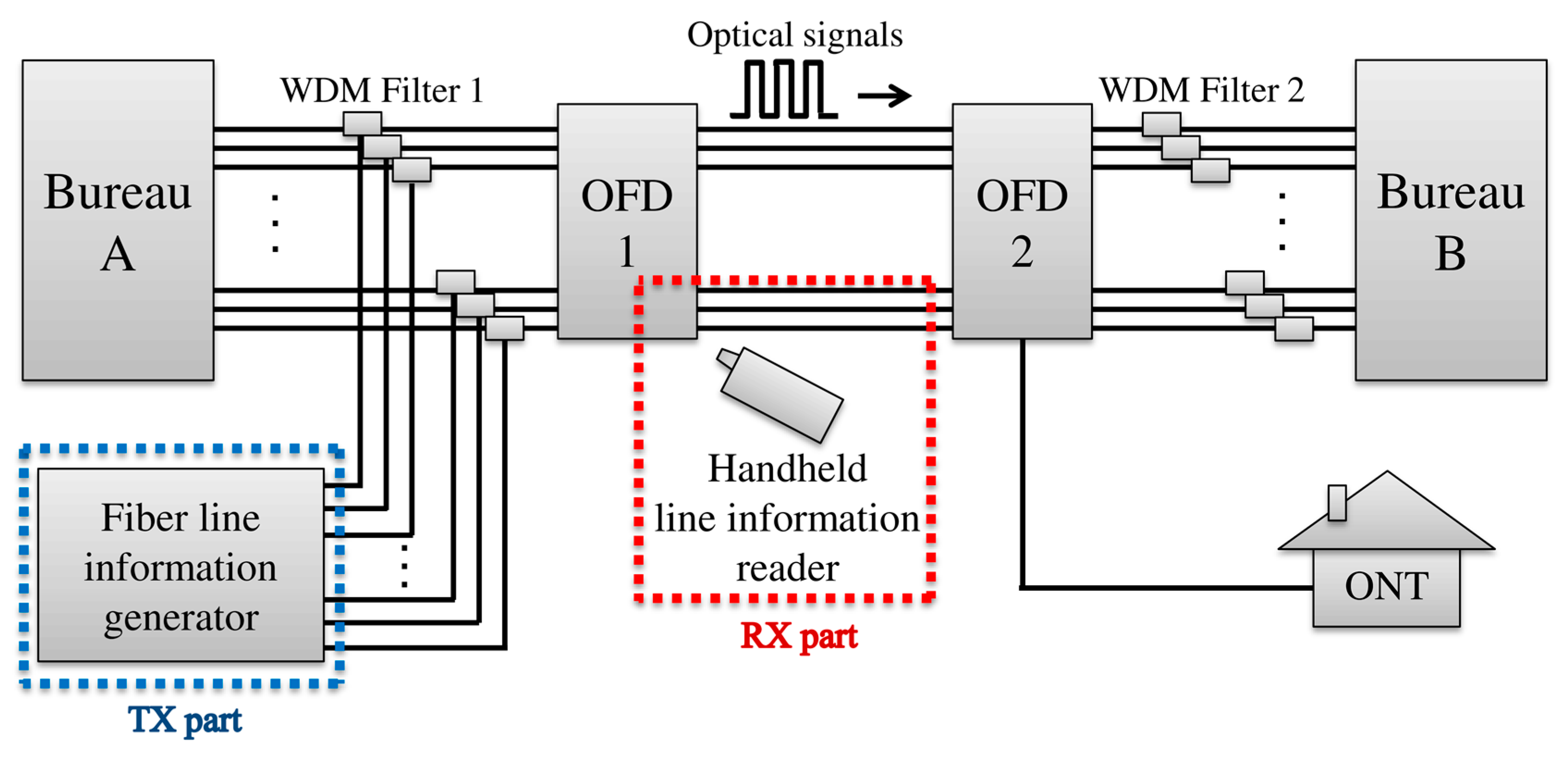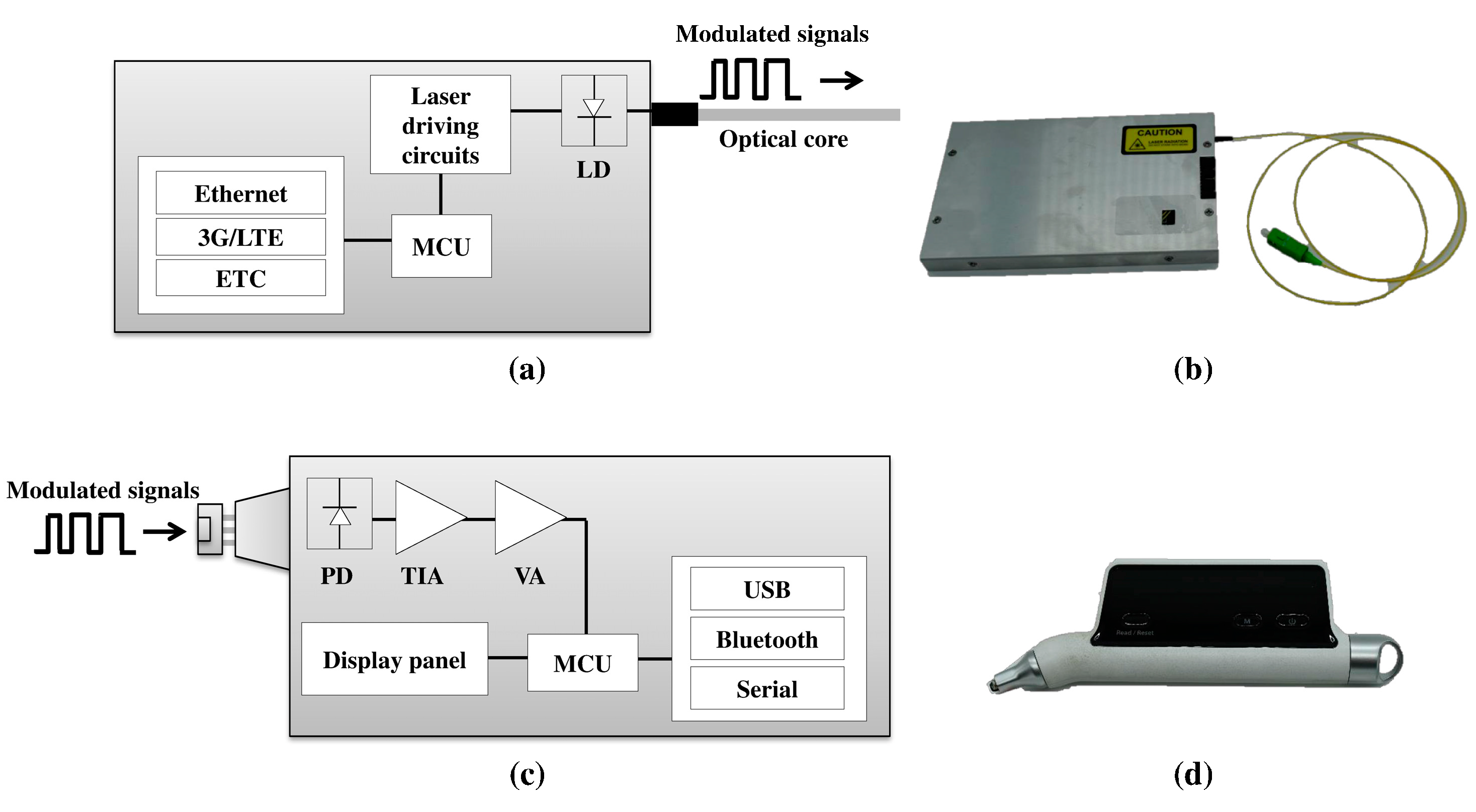Development of a Handheld Line Information Reader and Generator for Efficient Management of Optical Communication Lines
Abstract
:1. Introduction
2. Experimental Setup and Methods
3. Results and Discussion
4. Conclusions
Acknowledgments
Author Contributions
Conflicts of Interest
References
- Coffman, K.G.; Odlyzko, A.M. Internet growth: Is there a “Moore’s Law” for data traffic? In Handbook of Massive Data Sets; Abello, J., Pardalos, P.M., Resende, M.G.C., Eds.; Springer: Boston, MA, USA, 2002; pp. 47–93. [Google Scholar]
- Desurvire, E. Optical communications in 2025. In Proceedings of the 31st European Conference on Optical Communication, Glasgow, UK, 25–29 September 2005; pp. 5–6. [Google Scholar]
- Gerstel, O.; Jinno, M.; Lord, A.; Yoo, S.B. Elastic optical networking: A new dawn for the optical layer? IEEE Commun. Mag. 2012, 50, s12–s20. [Google Scholar] [CrossRef]
- Tkach, R.W. Scaling optical communications for the next decade and beyond. Bell Labs Tech. J. 2010, 14, 3–9. [Google Scholar] [CrossRef]
- Wielandy, S.; Fishteyn, M.; Zhu, B. Optical performance monitoring using nonlinear detection. J. Lightwave Technol. 2004, 22, 784–793. [Google Scholar] [CrossRef]
- Mitra, P.P.; Stark, J.B. Nonlinear limits to the information capacity of optical fiber communications. arXiv, 2000; arXiv:physics/0011016. [Google Scholar]
- Shinohara, H. Broadband access in Japan: Rapidly growing FTTH market. IEEE Commun. Mag. 2005, 43, 72–78. [Google Scholar] [CrossRef]
- Park, S.-J.; Lee, C.-H.; Jeong, K.-T.; Park, H.-J.; Ahn, J.-G.; Song, K.-H. Fiber-to-the-home services based on wavelength-division-multiplexing passive optical network. J. Lightwave Technol. 2004, 22, 2582. [Google Scholar] [CrossRef]
- Kramer, G.; Pesavento, G. Ethernet passive optical network (EPON): Building a next-generation optical access network. IEEE Commun. Mag. 2002, 40, 66–73. [Google Scholar] [CrossRef]
- Yuksel, K.; Moeyaert, V.; Wuilpart, M.; Mégret, P. Optical layer monitoring in passive optical networks (PONs): A review. In Proceedings of the 10th Anniversary International Conference on Transparent Optical Networks, Athens, Greece, 22–26 June 2008; pp. 92–98. [Google Scholar]
- Watekar, P.R.; Ju, S.; Han, W.-T. Single-mode optical fiber design with wide-band ultra low bending-loss for FTTH application. Opt. Express 2008, 16, 1180–1185. [Google Scholar] [CrossRef] [PubMed]
- Mukherjee, B. WDM optical communication networks: Progress and challenges. IEEE J. Sel. Areas Commun. 2000, 18, 1810–1824. [Google Scholar] [CrossRef]
- Mukherjee, B. Optical WDM Networks; Springer Science & Business Media: Berlin, Germany, 15 June 2006. [Google Scholar]
- Dwivedi, A.; Wagner, R.E. Traffic model for USA long-distance optical network. In Proceedings of the Optical Fiber Communication Conference, Baltimore, MD, USA, 7 March 2000; pp. 156–158. [Google Scholar]
- Armstrong, J. OFDM for optical communications. J. Lightwave Technol. 2009, 27, 189–204. [Google Scholar] [CrossRef]
- Mayrock, M.; Haunstein, H. Monitoring of linear and nonlinear signal distortion in coherent optical OFDM transmission. J. Lightwave Technol. 2009, 27, 3560–3566. [Google Scholar] [CrossRef]
- Zhang, H.; Wang, S.; Gong, Y.; Liu, T.; Xu, T.; Jia, D.; Zhang, Y. A quantitative robustness evaluation model for optical fiber sensor networks. J. Lightwave Technol. 2013, 31, 1240–1246. [Google Scholar] [CrossRef]
- Xu, T.; Jacobsen, G.; Popov, S.; Forzati, M.; Mårtensson, J.; Mussolin, M.; Li, J.; Wang, K.; Zhang, Y.; Friberg, A.T. Frequency-domain chromatic dispersion equalization using overlap-add methods in coherent optical system. J. Opt. Commun. 2011, 32, 131–135. [Google Scholar] [CrossRef]
- Rossi, G.; Dimmick, T.E.; Blumenthal, D.J. Optical performance monitoring in reconfigurable WDM optical networks using subcarrier multiplexing. J. Lightwave Technol. 2000, 18, 1639. [Google Scholar] [CrossRef]
- Dakin, J.P. Distributed optical fiber sensors. In Proceedings of the Distributed and Multiplexed Fiber Optic Sensors II, Fibers’ 92, Boston, MA, USA, 8–11 September 1993; pp. 76–108. [Google Scholar]
- Kilper, D.; Bach, R.; Blumenthal, D.; Einstein, D.; Landolsi, T.; Ostar, L.; Preiss, M.; Willner, A. Optical performance monitoring. J. Lightwave Technol. 2004, 22, 294–304. [Google Scholar] [CrossRef]
- Maeda, M.W. Management and control of transparent optical networks. IEEE J. Sel. Areas Commun. 1998, 16, 1008–1023. [Google Scholar] [CrossRef]
- Pan, Z.; Yu, C.; Willner, A.E. Optical performance monitoring for the next generation optical communication networks. Opt. Fiber Technol. 2010, 16, 20–45. [Google Scholar] [CrossRef]
- Zeng, H.; Huang, C. Fault detection and path performance monitoring in meshed all-optical networks. In Proceedings of the Global Telecommunications Conference, Dallas, TX, USA, 29 November–3 December 2004; pp. 2014–2018. [Google Scholar]
- Zhou, D.; Subramaniam, S. Survivability in optical networks. IEEE Netw. 2000, 14, 16–23. [Google Scholar]
- Park, S.-B.; Jung, D.; Shin, H.; Shin, D.; Hwang, S.; Oh, Y.; Shim, C. Optical fault monitoring method using broadband light source in WDM-PON. Electron. Lett. 2006, 42, 239–241. [Google Scholar] [CrossRef]
- Park, J.; Baik, J.; Lee, C. Fault-detection technique in a WDM-PON. Opt. Exp. 2007, 15, 1461–1466. [Google Scholar] [CrossRef]
- Li, C.-S.; Ramaswami, R. Automatic fault detection, isolation, and recovery in transparent all-optical networks. J. Lightwave Technol. 1997, 15, 1784–1793. [Google Scholar]
- Uttam, D.; Culshaw, B. Precision time domain reflectometry in optical fiber systems using a frequency modulated continuous wave ranging technique. J. Lightwave Technol. 1985, 3, 971–977. [Google Scholar] [CrossRef]
- Honda, N.; Iida, D.; Izumita, H.; Azuma, Y. In-service line monitoring system in PONs using 1650-nm Brillouin OTDR and fibers with individually assigned BFSs. J. Lightwave Technol. 2009, 27, 4575–4582. [Google Scholar] [CrossRef]
- Takada, K.; Yokohama, I.; Chida, K.; Noda, J. New measurement system for fault location in optical waveguide devices based on an interferometric technique. Appl. Opt. 1987, 26, 1603–1606. [Google Scholar] [CrossRef] [PubMed]
- Ly-Gagnon, D.-S.; Tsukamoto, S.; Katoh, K.; Kikuchi, K. Coherent detection of optical quadrature phase-shift keying signals with carrier phase estimation. J. Lightwave Technol. 2006, 24, 12. [Google Scholar] [CrossRef]
- Hanzo, L.; Ng, S.X.; Webb, W.; Keller, T. Quadrature Amplitude Modulation: From Basics to Adaptive Trellis-Coded, Turbo-Equalised and Space-Time Coded OFDM, CDMA and MC-CDMA Systems; IEEE Press-John Wiley: Hoboken, NJ, USA, 2004. [Google Scholar]
- Essiambre, R.-J.; Kramer, G.; Winzer, P.J.; Foschini, G.J.; Goebel, B. Capacity limits of optical fiber networks. J. Lightwave Technol. 2010, 28, 662–701. [Google Scholar] [CrossRef]
- Morgan, R.; Barton, J.; Harper, P.; Jones, J.D. Wavelength dependence of bending loss in monomode optical fibers: effect of the fiber buffer coating. Opt. Lett. 1990, 15, 947–949. [Google Scholar] [CrossRef] [PubMed]
- Chen, T.; Xie, Z.; Li, Z.-H.; Zhou, Y.-M.; Guo, H.-Y. Study on the monotonicity of bending loss of polymer optical fiber. J. Lightwave Technol. 2015, 33, 2032–2037. [Google Scholar] [CrossRef]
- Gloge, D. Bending loss in multimode fibers with graded and ungraded core index. Appl. Opt. 1972, 11, 2506–2513. [Google Scholar] [CrossRef] [PubMed]





| Focal Length of the Lens (mm) | Maximum Working Distance (mm) | Improvement of Maximum Working Distance (%) |
|---|---|---|
| - | 7.50 | - |
| 2.00 | 8.50 | 113 |
| 3.10 | 21.00 | 280 |
| 4.51 | 27.00 | 360 |
| 8.00 | 28.00 | 373 |
| Distance between Fiber and Photo Diode (mm) | Attenuation Value without Lens (dB) (a) | Attenuation Value with Lens of Focal Length 4.51 mm (dB) (b) | Improved SNR Value (dB) ((b)−(a)) |
|---|---|---|---|
| 20 | 4 | 10 | 6 |
| 15 | 5 | 11 | 6 |
| 10 | 8 | 13 | 5 |
© 2017 by the authors. Licensee MDPI, Basel, Switzerland. This article is an open access article distributed under the terms and conditions of the Creative Commons Attribution (CC BY) license (http://creativecommons.org/licenses/by/4.0/).
Share and Cite
Lee, J.; Kwon, H.; Song, J.; Jeon, M.; Kim, J. Development of a Handheld Line Information Reader and Generator for Efficient Management of Optical Communication Lines. Sensors 2017, 17, 1950. https://doi.org/10.3390/s17091950
Lee J, Kwon H, Song J, Jeon M, Kim J. Development of a Handheld Line Information Reader and Generator for Efficient Management of Optical Communication Lines. Sensors. 2017; 17(9):1950. https://doi.org/10.3390/s17091950
Chicago/Turabian StyleLee, Jaeyul, Hyungwoo Kwon, Jaewon Song, Mansik Jeon, and Jeehyun Kim. 2017. "Development of a Handheld Line Information Reader and Generator for Efficient Management of Optical Communication Lines" Sensors 17, no. 9: 1950. https://doi.org/10.3390/s17091950




